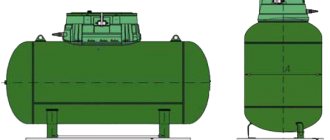Selecting and calculating a gas holder for a country house is a serious task, the solution of which determines not only the level of comfort during installation and operation, but also the safety of the residents of the gasified house and their neighbors. Factories for the production of gas tanks are located in countries such as Russia, the Czech Republic, Bulgaria, Italy and some other countries. However, these gas tanks are not always adapted to Russian operating conditions and often do not meet safety requirements. Let's look at the main types of gas tanks, their disadvantages and advantages.
Storage container
A gas tank is a container for storing gas, and in a specific situation of heating a country house, it is a container into which LPG, liquefied hydrocarbon gases, a mixture of butane and propane are poured. LPG is not at all the same gas that is supplied to houses through main gas pipelines - it uses methane-based fuel.
A gas holder differs from a conventional gas cylinder in size and stationarity; it is installed on the site for several decades and is periodically refueled from a special refueling machine. An underground gas pipeline is laid to the house from the reservoir (it must be at a certain distance), through which the evaporated gas flows to the boiler.
Gas tanks are made of steel and treated with special anti-corrosion compounds. The device is equipped with sensors that help control gas flow and indicate the pressure in the tank.
The history of gas holders began in 1781 in the laboratory of the French chemist Lavoisier. To store gas in his laboratory, he made a rectangular container with a capacity of 100 liters, and after a few years he realized that the gas holder should be cylindrical. Further, gas holders were used mainly in science, industry and urban utilities (for gas lamps).
Over time and the development of science, gas tanks changed, modified, and finally a variety appeared that is used for heating private houses. These are cylindrical tanks of constant volume that can withstand high pressure: there are tanks in which gas is stored at a pressure of up to 18 atm.
Varieties
According to their location in space, all gas tanks are classified into:
- ground;
- underground.
The gas tank must be buried to a depth of at least 60 centimeters from the surface of the earth.
The gas tank must be installed using a crane on a specially prepared concrete slab. Each vessel must be covered with a special protective coating against electrochemical corrosion. In the lowest section of the gas pipe running from the tank to the house, there should be a condensate collector that collects the liquid that is formed when the gas evaporates.
According to the type of construction, all gas tanks can be divided into:
- vertical;
- horizontal;
- mobile (mobile).
Mobile gas storage facilities stand separately among all gas tanks. A mobile gas holder is a small gas tank (its volume is usually 500 l), equipped with a heating system. Such a container is convenient to refill and can always be delivered to any place that is not equipped with a gas system.7
Site installation requirements
A gas holder is a dangerous object. But it is no more dangerous than many other heating systems. The design has a safety valve that will not allow the container to be filled above the safe limit and will prevent the risk of rupture; There are fuses - if something happens they will release the pressure. You can install a sensor that will shut off the gas if a leak occurs.
The installation of equipment is controlled by a number of regulatory documents, including SP 42-103-2003 (it regulates the installation of gas pipelines made of polyethylene pipes). According to all the rules, the tank must defend:
- 10 meters from a residential building;
- 2 meters to the foundations of other buildings;
- one and a half heights of the support to local power lines.
The place where the gas tank is buried cannot be concreted, planted with plants or paved with tiles. The walls of the pit should be flat, 2 meters wide and at least 1.9 meters deep. The length of the pit depends on the volume of the container:
- 5 meters for a gas holder with a volume of 4850 liters;
- 7 meters for a gas holder with a volume of 6400 liters;
- 10 meters for a gas tank with a volume of 9200 liters.
The tank fittings must always be above ground level, and there must be free access to the neck for refueling.
It is important that the nameplate, plate on which the serial number and basic information about the gas tank are indicated can be freely read at any time of the year throughout the entire service life of the equipment.
Profit or ruin
How profitable is a gas tank, does it pay for itself, and when does it make sense to install it in a country house or country house, and when not? This issue has been discussed on FORUMHOUSE for many years. There is no universal answer here, each case is individual, it all depends on the size and quality of insulation of the house, the climate of the region, and the prices of other types of fuel.
But here are the things we managed to agree on:
- Gas tank heating will be more profitable if you fill the tank once a year, in May. The cost of fuel in May is 20% lower than in October. But for this, the tank must have a sufficiently large volume.
- Gas holder heating is definitely cheaper than diesel heating, and in a number of regions of our country in terms of return on investment it ranks second after natural gas;
Westpoint FORUMHOUSE Member
Barrels with a volume of 4850 for a house of 130 sq.m. Should be enough for a year with a one-time refill. This is half of what I spend on pellets now.
- If the area of the house is more than 100 square meters, an autonomous gas heating system based on a gas holder may already be appropriate. If you just need to heat a small dacha, it would be better to go with electricity.
spbplumbing FORUMHOUSE Member
It all depends on capital investments, but a gas holder will be cheaper than a diesel boiler with piping, a chimney, a container, and installation.
KhrunchaModerator FORUMHOUSE
Personally, I don’t regret at all [that I buried the gas holder]. Ownership experience 8 years.
Even those people who loudly regret having installed gas tanks do not want to sell them.
Here are some reviews of how much it cost to heat a home with LPG for users of our portal last year, 2022.
MblParticipant FORUMHOUSE, Moscow.
The total area is 150 square meters + sauna 70. Of these, I constantly heat 60-70 m to + 21 degrees, in the sauna I maintain +5 all week, and +21 on weekends. Consumption per year under this regime is 40,000-45,000 rubles. There are about 2500 liters. I have a barrel with a volume of 4850 liters.
A member of our portal with the nickname IlyaKu has been operating a 6400 liter gas tank for four years. The area of his house is 10 square meters, and he chose such a large tank, planning to subsequently connect his relatives’ house to it. Both houses are permanent residences, without heated floors, with radiators.
IlyaKuForumHouse Member
While there was one house of 160 m2, there was enough fuel for the whole year and with a huge supply, the supply allowed you to choose when it was more profitable to refuel (minimum price May-June, maximum October-December).
After connecting the second house, a house with an area of 140 m2 has to be refueled twice a year, in total for two houses in 2022 it came out to 119,000 rubles, in the past 129,000.
FORUMHOUSE members who live close to each other find partners on the forum to refuel together. Judging by the reviews, this allows you to save from 50 kopecks to a ruble for each liter - it is much more profitable for gas stations to carry full tanks.
But this is about fuel consumption; Many people are more afraid of the cost of installing equipment. They are indeed considerable, but – and this can be looked at from different angles.
ChaleFORUMHOUSE Member
Believe me, compared to the cost of a house with some furniture and appliances, 350 thousand for everything including the first gas station will seem like a small amount.
Main stages of installing a gas tank and cost saving options
Installation of a gas holder for a country house
Most operations for installing a gas tank involve excavation work, which you can do yourself: either with your own hands or by using cheap labor. Let's assume that you have already chosen a gas tank and are ready to buy it (how to do this correctly will be discussed below). Now your task is to install it, below we provide recommendations on how this can be done and at the same time save a lot.
- We choose a contractor company. The main thing you need to pay attention to is that she must be a member of the SRO and have been installing gas tanks for more than a year.
- We invite a representative of the selected organization to your country house to draw up an installation diagram, which will indicate: the location of the gas tank installation site and the route for laying the gas pipeline. At the same time, we explain that you will do all the preparatory work yourself, having previously agreed with the chosen company.
This approach is quite acceptable and has been practiced for a long time. After all, the main interest of any gas company is, first of all, the sale of a gas tank and its further refueling, and in this you are not infringing on it. You just need to agree as precisely as possible on the list of work that you will undertake and the requirements for their implementation. Below we present those operations that can be performed without special qualifications.
- We believe that the gas tank has already been selected and purchased (or almost purchased), at least we know its dimensions. To install it, you will need to dig a pit, and its depth should ensure that the gas holder (after installing it on the bottom) is below the freezing layer of the soil. We immediately draw your attention to an important point: the gas tank fittings should under no circumstances be exposed to the danger of flooding.
- Before lowering the gas tank to the bottom, it is necessary to pour a foundation for it. In principle, you can buy a ready-made concrete slab, and it will be cheaper.
- Next, you need to dig a trench for laying the gas pipeline, its depth is approximately 170 cm.
Please note that to perform all of the above work, you can get by with a shovel; buying such a tool will not be too difficult, and brute physical force. Of course, you can use special equipment, but when installing a gas tank for a private home, it is unlikely to be profitable, the amount of work is too small.
If you feel that this is beyond your strength, then contact yours. Since 2004, our specialization has been the sale and installation of gas tanks in Moscow and the Moscow region. Contact our specialists for a free consultation, and they will tell you how much our services will cost you.
How to choose the volume of a gas tank
Modern industry produces different types of gas tanks. They differ in volume, design, type of location, material and wall thickness, price, and manufacturer. To choose the right one, you need to consider many different points.
The first criterion for choosing a gas tank is volume. Now gas tanks with a volume of 900 to 10,000 liters are offered, but it is better to buy one that is spacious enough so that you have to refuel no more than once a year - this is the most profitable tactic.
MblFORUMHOUSE Member
Typically, a 4850 capacity is enough for a house with an area of 190 square meters.
It is difficult to accurately calculate the volume; manufacturers recommend calculating fuel consumption using the formula 22–25 liters of gas volume per meter of house area. You can trust these companies, but it's better to be safe.
KhrunchaModerator FORUMHOUSE
Less than 4.8 cu. m. don't take it! The principle here is the same as in a car: you don’t have to wait until the bottom of the tank, it’s better to refuel in advance.
Most manufacturers strongly recommend adherence to the following filling parameters:
- not less than 5% (there should not be less fuel in the tank)
- no higher than 85% (do not fill the container more).
These indicators make it possible to maintain a working pressure in the gas tank at which its operation will be safe.
Gas boiler power calculation
The main share of fuel consumption is heating. An important parameter of any house or apartment that affects the amount of gas spent on heating is the heat loss indicator. The task of heating is precisely to correctly compensate for these losses, creating conditions for comfortable living.
In order to calculate the need for liquefied gas, it is necessary to determine the amount of heat loss at home or the thermal power required for full heating. The rated power of the heating system - gas boiler - depends on this indicator
As a standard for calculations, we will take a house located in an area with an average climate, in satisfactory condition and insulated in accordance with technology. The area of the house is 80 m2.
The average values of heat loss and boiler power can be determined by the quadrature of the area.
The formula looks like:
Q = S × Рр /10 , where
Q—calculated heat losses (kW);
S is the area of the premises that are heated (m2);
Рр - specific power of a gas boiler (kW/m2) - power for every 10 m2.
The specific power for heating an area of 10 m2 has already been approximately established, taking into account adjustments for regions with different climates. For our reference house, located, for example, in the Moscow region, Рр = 1.2 - 1.5 kW.
Taking into account a house area of 80 m2, the optimal power of the heating system will have the following value:
Q = 80 × 1.2 / 10 = 9.6 kW.
Although simplified, this formula reflects the most accurate results.
Often, for convenience in carrying out calculations, unit is taken as the value of specific power. Based on this, the power of the heating system is taken at the rate of 10 kW per 100 m2 of heating area.
Since the gas supply system of your home includes not only heating, but also water heating and other equipment, the boiler power is determined by adding 20-25% of the reserve to the calculated heat losses
The second option, but accepted with a greater degree of error, is to calculate the cost of thermal energy for the heat loss of a building by cubic capacity - the volume of heated premises. Depending on the climate zone, 30 - 40 W are allocated for heating one cubic meter of a room with a ceiling height of up to 3 m.
Vertical or horizontal
Gas tanks that are installed vertically are of more interest to owners of small plots: this way they can comply with all placement requirements and save precious space. This is the most important advantage of vertical gas holders, and for this reason they are so popular in European countries.
In our country of large territories and high groundwater levels, the horizontal option is more common.
Andrey2 Member of FORUMHOUSE
It is cheaper to bury a horizontal one, but if the groundwater level is high, then the vertical one is more difficult to install.
About the fact that “vertical gas tanks have a small evaporation mirror, and with a large analysis there may be a lack of gas fraction” - on the portal there are quite a few owners of vertical tanks who did not feel any inconvenience at all from the small evaporation mirror.
Principle of operation
The principle of operation of a gas tank is quite simple: gas is pumped into a tank, and due to the fact that the tank is not completely filled, an air-gas mixture (propane-butane) is formed in the empty space of the storage. In order for the natural evaporation process to take place effectively, several rules should be followed:
- Do not fill the container with liquefied gas more than 85%.
- When installing a tank, it is necessary to strictly take into account that it should not be cooled below 0°, therefore, if a ground-based gas tank is installed, it will need to be insulated.
- If it is assumed that the evaporation area will be small (for example, in vertical containers), then it is necessary to consider an additional system of evaporators.
The gas mixture enters the house through a pipeline, just like through a regular pipeline. The gas tank is filled by specialists working on a machine with a filling tank. The procedure itself is reminiscent of refueling a car at a gas station.
Above ground or underground
Based on the type of occurrence, reservoirs are divided into above-ground and underground. In most cases, Russian homeowners choose underground ones. This is a dire necessity. How a gas tank works: at positive temperatures, the liquefied fuel in it evaporates and turns into gas, the valve opens, and the gas flows through the gas pipeline into the house, to the boiler. Under the ground around the walls of the container there are always positive temperatures - this is the main advantage of an underground gas tank. And the ground-based one may need to install special evaporators.
CrimsonFORUMHOUSE Member
That’s why large gas tanks are buried to prevent them from freezing. And preferably with a high neck, so that the gas itself is deeper - it’s warmer there.
But some owners of gas tanks believe that all tanks, regardless of the type of location, need additional heating of the gearbox.
StanspbFORUMHOUSE Member
In winter, it can freeze to very low temperatures, crack and stop regulating the gas supply. So I consider it necessary to heat the gearbox.
There is another type of gas holder - mobile or portable.
Usually this is a gas tank for the country - a cylinder with a capacity of about 700 liters on a car trailer that can be transported to a gas station. Mini gas holders cope with their tasks quite well.
MosKvachFORUMHOUSE Member
The mobile is placed on the base or works directly from the trailer. Moreover, there are also winter kits to prevent freezing in cold weather.
Tips for saving gas
You can reduce gas consumption from a gas tank by performing the following energy-saving measures:
- insulation of walls, roofs, attics, basement floors;
- replacing old window units with modern double-glazed windows with frost-free profiles;
- optimal setting of boiler parameters;
- installation of an energy-efficient condensing-type gas boiler for heating;
- the use of a collector heating system, which has a higher efficiency and the ability to regulate the coolant supply on each heating device;
- equipping heating radiators with thermostats.
A good gas saving effect is achieved through the installation of controllers that automate the process of heat supply control.
The controller, depending on the specified settings, automatically controls autonomous heating, which allows you to significantly minimize the consumption of LPG from the gas tank and reduce heating costs by up to 25%.
Moreover, modern controllers are, as a rule, smart devices with which you can remotely control the boiler from a mobile phone.
An inexpensive alternative to such remote-controlled devices are programmable or daily thermostats, which also allow you to save energy.
A modern solution for saving gas from an autonomous storage facility is the “smart home” system.
Along with a large range of useful functions that make life easier, the use of smart home technology allows for automatic climate control
The climate control function in the house can be installed separately or integrated into a general set of “utilities”.
Such technologies make it possible to economically use gas for heating throughout the day in individual rooms. You can configure the system to operate in heating mode when there are no residents and turn on full heating remotely before arriving home.
The main problem with implementing a “smart home” climate control system is the relatively high cost of the issue and the need for design before installation of the heating system.
Material and wall thickness
Household gas tanks are made of steel, and its grade and thickness depend on the manufacturer. Domestic manufacturers usually use low-alloy steel 09G2S and 17G1S and apply a layer of bitumen to the containers. Experts always recommend checking the bitumen coating layer of the gas holder to ensure that there is no damage to them.
According to GOST 14249-89, for a design pressure of 1.8 MPa, the design wall thickness should be at least 6-6.13 mm (for vessels with bottoms of 1200-1250 mm.) And most domestic manufacturers adhere to this standard. The wall thickness of foreign-made gas tanks is 4.5 -5.7 mm.
SLEngineer, FORUMHOUSE user
You need to take domestically produced gas tanks with a wall thickness of 8mm.
But foreign gas tanks are made of steel, the quality of which is higher.
RavenFORUMHOUSE member, metallurgist
In Europe, there is a different approach - good steel, which does not make sense to make thick; professional coating is applied without air and solvents at high temperatures.
Users of our portal bought different gas tanks, there are those who are not happy with the domestic ones “made of thick steel”, there are those who are satisfied with the “bourgeois” ones. Here you need to make a choice, as with any other responsible purchase - and a gas tank is bought for 20-40 years - study the forum, read reviews, ask for advice.
KhrunchaModerator FORUMHOUSE
Personally, after 3 years of studying, I settled on an imported barrel, it is made of good steel, and even coated with epoxy.
Another point is the high neck of the gas tank, how much is it needed? This design feature makes the gas tank several tens of thousands of rubles more expensive.
BlehmanFORUMHOUSE Member
A high neck, in addition to protection from high groundwater level, allows you to maintain and, in the long term, examine the condition of the gas holder without digging it up, and to deepen the body of the gas holder to a depth more comfortable for LPG evaporation.
In practice, this difference of 30-50 cm does not give much, but you can examine the condition of the gas tank without it. Here people pay, rather, for their own peace of mind and confidence in the safety of gas equipment.
BaracudaMyNikFORUMHOUSE Member
The high neck is my peace of mind, plus, as they say, double welding. I will definitely take it from the high end.











